| کد مقاله | کد نشریه | سال انتشار | مقاله انگلیسی | نسخه تمام متن |
|---|---|---|---|---|
| 6231600 | 1608145 | 2015 | 6 صفحه PDF | دانلود رایگان |
- Symptom and contextual variables contribute to decisions regarding depressive subtype.
- RPART evaluation of the SMPI demonstrated high diagnostic sensitivity and specificity.
- Relatively few items were required for clinical differentiation of depressive subtype.
BackgroundStudies suggest that differentiating melancholic from non-melancholic depressive disorders is advanced by use of illness course as well as symptom variables but, in practice, potentially differentiating variables are generally positioned as having equal value. Judging that differentiating features are more likely to vary in their signal intensity, we sought to determine the number of features required to effect differentiation and their hierarchical order.MethodsThe 24-item clinician-rated Sydney Melancholia Prototype Index (SMPI-CR) was completed for 364 unipolar depressed patients. The sample was divided into two cohorts according to the recruitment period. An RPART classification tree analysis identified the most discriminating SMPI items in the development sample of 197 patients, and examined the sensitivity and specificity of the diagnostic decisions, then sought to replicate findings in a validation sample of 169 patients.ResultsIndependent analyses of putative SMPI items identified only seven items as required to discriminate those with clinically-diagnosed melancholic or non-melancholic depression when the conditions were examined separately. An RPART analysis considering differentiation of melancholic and non-melancholic depression in the total samples retained five of those items in the classification tree, three of which were non-symptom items, and with 92% sensitivity and 80% specificity in the development sample. This reduced item set showed 93% sensitivity and 82% specificity in the validation sample.LimitationsOur clinical judgment of melancholic or non-melancholic depression may not correspond with the clinical logic employed by other clinicians.ConclusionOnly five SMPI items were required to derive a succinct and efficient decision tree, comprising high sensitivity and specificity in differentiating melancholic and non-melancholic depression. Current study findings provide an empirical model that could enrich clinicians׳ approach to differentiating melancholic and non-melancholic depression.
Journal: Journal of Affective Disorders - Volume 180, 15 July 2015, Pages 148-153
